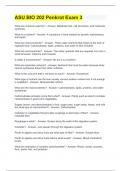Exam (elaborations)
ASU BIO 202 Penkrot Exam 3 Questions and Answers
- Module
- ASU BIO 202 Penkrot Exam 3
- Institution
- ASU BIO 202 Penkrot Exam 3
ASU BIO 202 Penkrot Exam 3 What are nutrients used for? - Answer- Metabolic fuel, cell structures, and molecular synthesis. What is a nutrient? - Answer- A substance in food needed for growth, maintenance, and repair. What are macronutrients? - Answer- Three major nutrients that make up th...
[Show more]



